Fresno has long been a law and order city. But data spanning Fresno’s justice system — from its streets to its schools to its jail — reveal its residents aren’t treated equally.
Routine interactions with the police put a much heavier burden on black Fresnans than white, data obtained from the city’s police department shows.
A year’s worth of data on traffic stops, car searches and arrests — obtained through a public records request and revealed here for the first time — provides the most complete look available at the role of race in policing in Fresno.
An analysis of more than 40,000 traffic stops in 2016 shows that black drivers accounted for 15 percent of officers’ stops — twice their share of the city’s driving-age population and nearly triple the rate that white drivers were stopped.
Traffic stops by race
Comprehensive national data on traffic stops doesn’t yet exist, but the racial disparity found in Fresno persists at similar rates in cities and states across the country, from New Haven to Sacramento.
In Fresno, it’s a powerful trend that doesn’t spare even the city’s most prominent black residents.
In a February interview at his office in City Hall, Councilman Oliver Baines, who is black, paused before answering a question about the Fresno Police Department’s disproportionate stopping of black drivers. On a coat rack behind him hung a jacket with a Fresno Police badge sewn onto the shoulder. Baines was a police officer for 10 years.
“You know I got pulled over last night — this is a great example,” Baines said. He recounted how he was stopped driving to his home in southwest Fresno. The officer didn’t recognize Baines and told him he was speeding, but Baines knew he wasn’t and said so.
“Well, it sounded like you were going kind of fast,” the officer replied. The officer then told him that Baines’ license plate was similar to the plate of a recently stolen vehicle. After looking over his driver’s license, the officer let Baines go.
“So, just like that,” Baines said. “No real reason whatsoever. He kind of manufactured one in the end, but this happens all the time. This is a prime example of how it happens.”
It was a typical stop in another way, too: Baines was pulled over in Fresno’s southwest, a diverse neighborhood with the city’s highest concentration of black residents.
Looking at where drivers are stopped provides yet another measurement of the city’s segregation — and the department’s policing patterns. Fresno police made more traffic stops in the southwest than any other part of the city.
Traffic stops mapped: Where Fresnans live and where they're pulled over
Drag the bar left and right to see where black Fresnans live and where they are stopped. Notice how the southwest corner of the city gets darker when looking at the concentration of traffic stops. This means that in that part of the city black drivers make up a larger share of traffic stops than of the residential population. Source: Fresno Police Department
Drag the bar left and right to see where white Fresnans live and where they are stopped. Notice how this compares with the previous chart. The white population is concentrated in the city's northern neighborhoods and white drivers make up a smaller percentage of traffic stops throughout the city. Source: Fresno Police Department
Drag the bar left and right to see where Hispanic Fresnans live and where they are stopped. Notice that Hispanic drivers are stopped at higher rates in neighborhoods where they make up a smaller share of the population. Source: Fresno Police Department
“We know that certain parts of town are policed more than others,” said Matthew Jendian, a sociology professor at Fresno State. Criminologists have noted that police patrol poor communities of color looking to suppress crime, whereas, in wealthy white neighborhoods, they’re mostly responding to crime.
Police officials have said the reason for this is simple: they patrol, stop, search and arrest more people in neighborhoods where there’s more crime. Baines, as a former Fresno police officer, is sympathetic to this explanation, but said it cannot account for the massive disparity.
“That doesn't fly with me,” he said.
The assertion isn’t supported even by the department’s own crime data. Data that spans the last five years shows that three of the five policing districts see a similar number of violent and drug crimes: 25 percent of the crimes happen in the Southeast district and 22 percent in the Central and Southwest districts, respectively.
In an interview, police chief Jerry Dyer acknowledged that his officers may have biases — “Every human being has some form of a bias” — but said the real reason for the disproportionate numbers is the gang violence in southwest Fresno that stems from long feuding factions. Whenever there’s a gang-related shooting, the department expects retaliation and they flood the streets.
“What we literally try to do is stop the bleeding and get into those neighborhoods and make a lot of traffic stops,” he said. “Now that is unique to West Fresno, I will say that.”
Dyer said he sometimes worries about the message this policing practice — comparable to “stop-and-frisk” — sends, especially during a time of increased public scrutiny of departments’ treatment of people of color.
Stops by police district
Chief Dyer responds to mother's concerns about his officer's conduct.
“Is it going to send a message publicly that we're now stopping more African-Americans and Hispanics than we are whites?” he said, adding that he has decided to deploy fewer officers after shootings, “so as to not have those numbers look so dramatic.”
Worrying about public perception “should not be anything that weighs on the chief's mind” when responding to those crimes, he said. Instead of focusing on the demographics of people stopped, Dyer said, people should look at data on crime victimization.
(He brought a printout from a department crime analyst to the interview, but the underlying data was not made available by the time of publication.)
In 2017, 32 percent of shooting victims were black, the printout said.
“That is why we’re there,” Dyer said. “Victimization is the foundation of who we detain and who we arrest.”
The increased police presence after shootings is simply a response to those communities’ calls for more protection, Dyer said.
“I do not want our officers going into any neighborhood and being seen as an occupying force.”
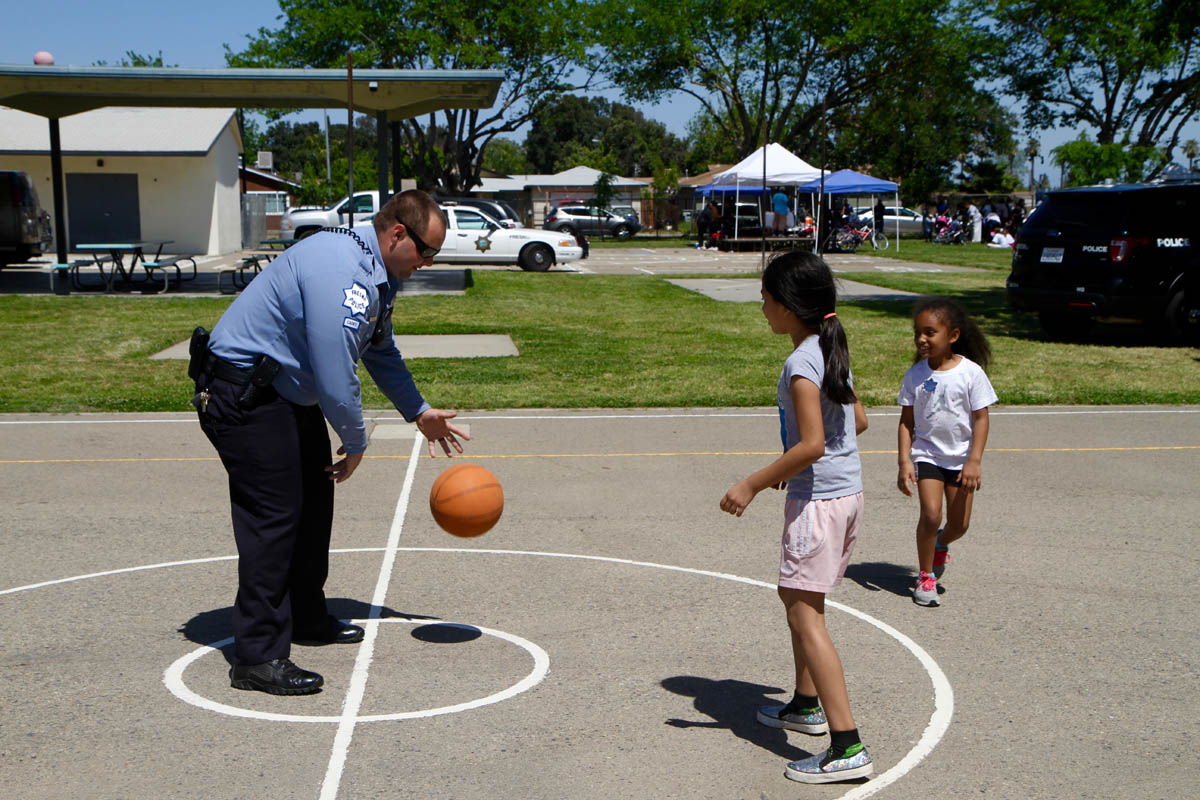
Hear Keyshawn talk to his mother about his interactions with the police.
Even if an area like Fresno’s southwest had crime rates that were much higher, some law enforcement professionals say that heavy traffic enforcement will not help.
“There is no evidence that just increasing stops reduces crime,” said Ron Davis, a former police chief and adviser to President Obama, in an interview with the New York Times. “For any chief who faces those racial disparities, they should be of great concern.”
In recent years, high-profile police shootings caught on video — like the killings of Samuel DuBose in Cincinnati and Philando Castile in a St. Paul suburb — have shown that routine traffic stops can quickly become deadly, especially when a driver feels targeted.
“When someone feels their rights are being violated, yeah, they're going to be upset and they have the right to be upset,” Baines said. “Now, I never condone not obeying police officers. But I also understand that pulling someone over, stopping someone, without real clear explanation as to why, can be the beginning of an escalation.”
Baines wasn’t ticketed. The officer didn’t search his car or arrest him. But the analysis of Fresno police traffic stop data reveals that officers search black drivers at a rate two and a half times that of white drivers and arrest black drivers twice as often.
This highlights a troubling trend: as police interactions get more serious, the disparities become more profound.
Of the 4,800 cars that Fresno police searched in 2016, a quarter belonged to black drivers, yet black drivers make up just 8 percent of the city’s driving age population.
In raw numbers, more black drivers had their cars searched than whites even though nearly 3,000 more white drivers were stopped.
Searches (per 1,000 stops)
More black drivers were arrested, too. Black drivers account for a higher percentage of those arrested than whites, even though the white driving-age population is four times the black driving-age population.
Arrests (per 1,000 stops)
The Northern California chapter of the American Civil Liberties Union found a similar pattern in officer-involved shootings. In a recent report, the ACLU found that, between 2011 and 2016, 22 percent of the people Fresno police officers shot or shot at were black — nearly triple the black share of the population.
ACLU researchers called their analysis of officer-involved shootings “A Tale of Two Cities,” and they wrote that, within Fresno’s “segregated communities, there are significant demographic differences between where officer-involved shootings occur and the likelihood of exposure to officer-involved shootings.”
If you’re a white, wealthy resident of north Fresno, the researchers wrote, you’re unlikely to be exposed to an officer-involved shooting. But if you’re one of south Fresno’s poor black and brown residents, you’re at a much greater risk.
When the ACLU report came out, in 2017, Dyer told the Fresno Bee that the findings of racial disparities were “without merit” but also said that the disproportionate use of force corresponds with high crime populations.
“There are going to be more uses of force, (including) deadly force, in neighborhoods that are plagued by gangs and violent crime,” he said.
At the end of his interview with this reporter, Dyer pointed to another print out: a list of the department’s “most wanted” people. “We can’t plug in a bunch of white guys,” he said. “You know who’s shooting black people? Black people. It’s black-on-black crime.”
This view, that so-called “black-on-black crime” is what is actually driving the perception of discrimination in policing, has been widely debunked. A recent study by the U.S. Department of Justice found that, overwhelmingly, violent crimes are committed by people who are the same race as their victims. “Black-on-black” crime rates, the study found, are comparable to “white-on-white” crime rates.
In the interview, Dyer said that the disproportionate rates of stops, searches and arrests of black drivers are indicators of a community struggling with gang violence and fatherless homes.
“I think the traffic stops are really symptomatic of a much bigger and broader challenge in our city and across America,” he said.
Symptomatic they may be, but of an entirely different malady: a legacy of racism and segregation.
FRESNO'S MASON-DIXON LINE
To understand the inequalities in Fresno’s justice system today, you need to go back in time 150 years, to the city’s post-Gold Rush-era founding.
It has been segregated ever since.
“The inequality in the criminal justice system in Fresno really begins with a history of how Fresno has grown and how segregation, both economic and ethnic, has developed over the last century,” Jendian said.
Settled by homesteaders and land speculators, Fresno developed around a railroad station in a pattern so common in the rapidly industrializing country that it has since borne a cliché: the poorest residents and residents who were not white were forced to live “on the other side of the tracks.”
“Without a doubt historically, Fresno's west side represents the most segregated and ghettoized area in the city.” - Ramón Chacón, late historian, in a 1988 report
At an 1873 town meeting, Fresno’s white residents agreed not to rent, sell or lease any land east of the railroad tracks, where they and their families lived, to Chinese immigrants, many of whom built the very tracks that cut them off from the rest of Fresno.
This set in motion “the creation of a segregated ghetto that has lasted to the present day,” wrote Ramón Chacón, a historian who grew up in west Fresno and researched racism and segregation in his hometown.
Chacón, who died in 2017, documented the early and often violent segregation of the Chinese population to neighborhoods in southwest Fresno, which is also sometimes called west Fresno or the west side.
In one essay1, Chacón reported that, in 1893, white rioters chased 300 Chinese workers from Fresno farms back to the city’s Chinatown, using “blows and pistol shots.”
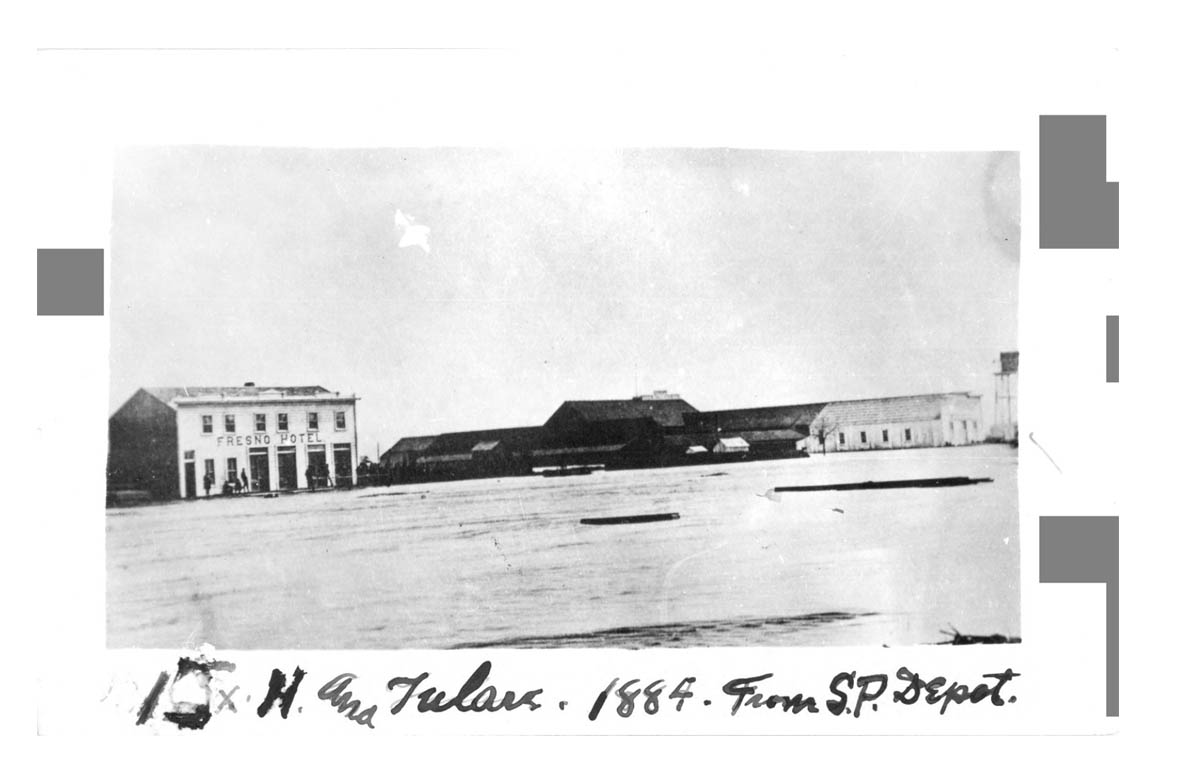
Over the next 25 years, the city grew quickly and attracted Mexican, Japanese, Armenian and Italian immigrants, who were also forced to live in southwest Fresno. In 1918, a California state commission report titled “Fresno’s Immigration Problem” said that nearly all of the city’s “foreign born” lived in the “Foreign Quarter” on the west side.
Also in 1918, Fresno’s first ever general plan formalized existing residential segregation by reserving the southern quadrants of the city for both industry and affordable housing. The zoning rules established a pattern that persists today: Fresno’s poorest and most vulnerable residents were consigned to the same neighborhoods as the city’s dirtiest factories.
By the time James Helming, a junior field agent from a New Deal agency called the Home Owners’ Loan Corporation, arrived in Fresno, the demographics on the west side had begun to shift. The Armenian, Russian and Italian residents had begun moving north and the black and Hispanic populations were growing. It was the mid-1930s and Helming would have been aware of the area’s racial makeup — it was his job, after all, to assess neighborhood “desirability” as part of the federal agency’s then-secret study.
Helming’s report, one of more than 200 from cities across the country, reinforced residential segregation through a practice that came to be known as “redlining.”
The Home Owners’ Loan Corporation and its field agents drew color-coded maps to determine who would get the credit necessary to buy houses. White neighborhoods were shaded green and approved for loans. Neighborhoods shaded red were denied them, based on their “undesirable” residents. Fresno’s west side was red and Helming noted the “almost exclusive concentration of colored races” present there.
The report also remarked with approval that, in the best neighborhoods, like Fig Garden, “residence lots were sold under careful deed restrictions as to race.” These deed restrictions, known as racially restrictive covenants, were yet another mechanism that prevented people of color from buying homes in white neighborhoods.
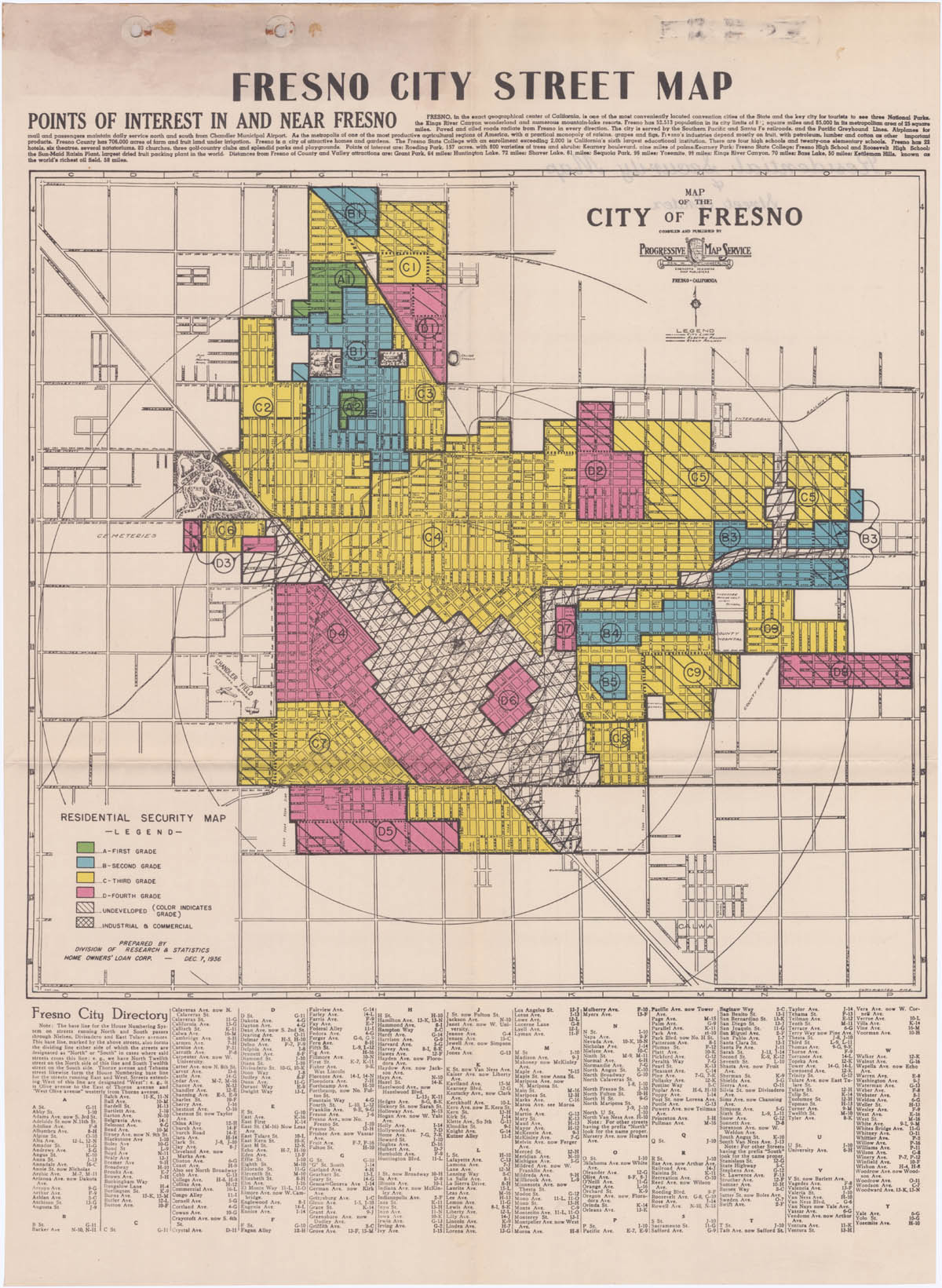
These policies made it virtually impossible for black Americans, who came to Fresno in greater numbers after World War II, to move in anywhere but the city’s southwest. One report estimated that, by the 1950s, nearly 100 percent of black Fresnans lived on the west side. Another found that, in 1960, Fresno had the highest degree of black-white segregation in California.
In the 50s, the construction of Highway 99, which today runs north and south through the Central Valley, created another physical barrier between the west side and the rest of Fresno and destroyed more than 20 blocks of existing housing. Later, at the height of the Cold War, a member of the California Legislature would refer to Highway 99 and the railroad tracks as “Fresno’s Berlin Wall.”
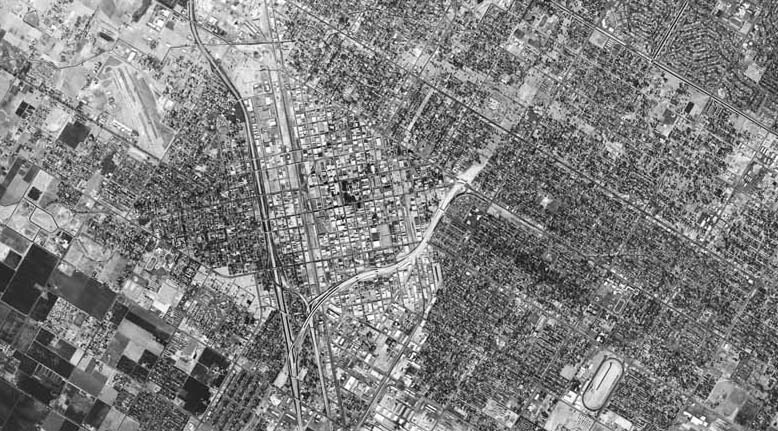
In 1973, the U.S. Department of Health, Education and Welfare found that Fresno Unified School District was in violation of the Civil Rights Act.2
Chacón, Ramón. “A Case Study of Ghettoization and Segregation: West Fresno’s Black and Chicano Community during the 1970s.” Palo Alto: Working Paper Series No. 12. 1986.
Not only did the district have heavily segregated schools (Edison High School, in the city’s southwest, had a population that was 99.6 percent minority students), a hallmark of segregated neighborhoods, but school administrators had “discriminatorily assigned Spanish surname and black students to mentally retarded classes.”
In the decades that followed, city plans and zoning ordinances kept the southwest isolated. Fresno’s leaders concentrated the city’s wealth and development farther north, catering to its affluent white neighborhoods. There, the city built shopping malls, hospitals and college campuses. The southwest got slaughterhouses and meatpacking plants.
The geographic, economic and racial isolation of a city’s black and brown residents explains how and why the criminal justice system treats them differently, said Richard Rothstein, author of The Color of Law, which details government policies that segregated U.S. neighborhoods.
“Fresno is no different than any other place in this respect,” Rothstein said. “You wouldn’t have the kinds of conflicts that existed in Ferguson or Baltimore, Milwaukee or St. Paul, or any of the hundreds of others over the years if you weren’t concentrating low-income young African American men in single neighborhoods where there’s little hope.”
In Fresno, segregation that began with Chinese immigrants evolved over time to target Hispanic and, most explicitly and acutely, black residents.
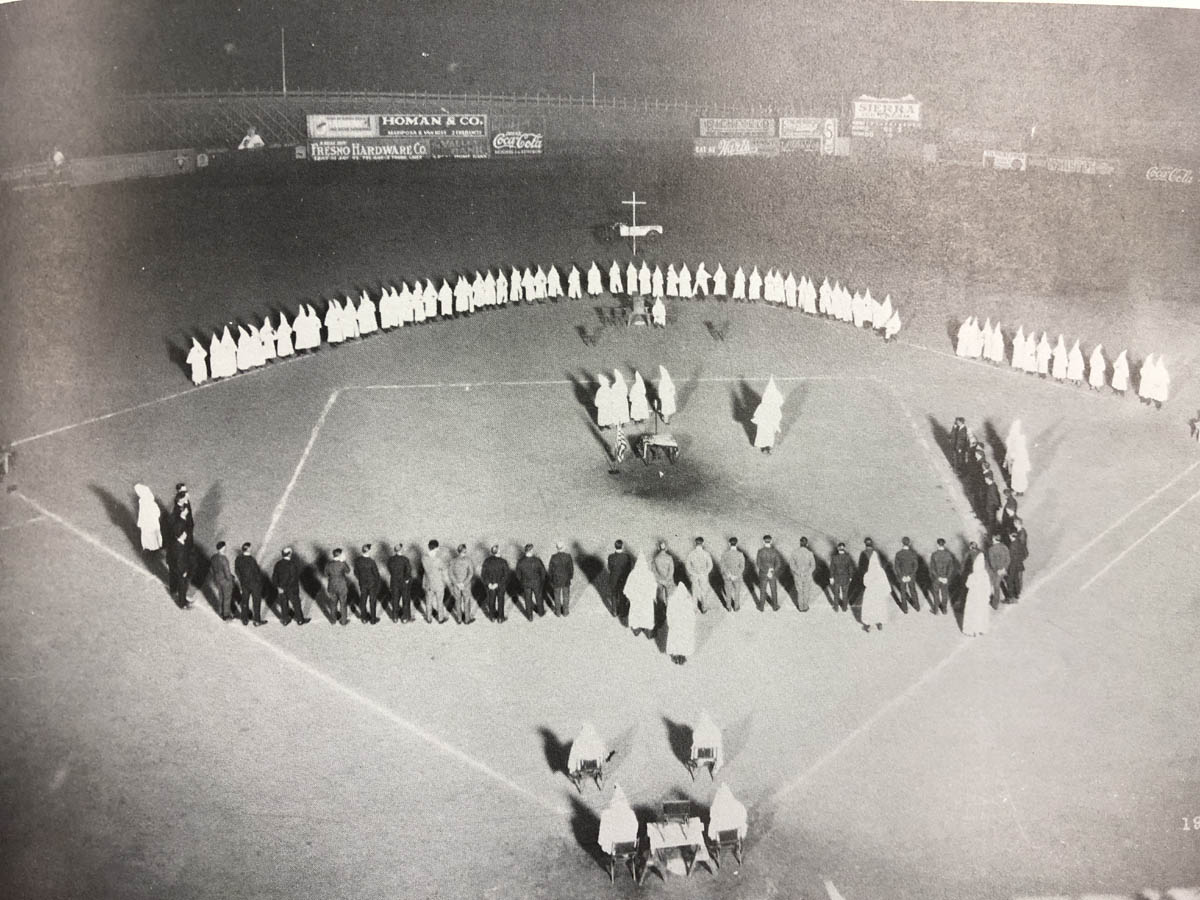
“Once you have a group of people segregated into a place you can take resources from that place,” said Amber Crowell, a Fresno State sociologist. “This creates racial disparities, health disparities, exposure to crime and over policing. It creates a monster of social inequality that falls along racial lines, then it recreates itself. The boundaries are put in place and it automates itself from there.”
Today, some argue that Shaw Avenue has replaced the railroad tracks as the city’s dividing line — white and wealthy to the north, poor, black and Hispanic to the south. A 1970s-era city planning document actually refers to the thoroughfare as Fresno's Mason-Dixon Line.3
There are exceptions, and pockets of prosperity and poverty exist above and below Shaw, but still, the side of the street a person lives matters — especially when it comes to interactions with the Fresno Police Department.
'LIKE GOD IN THIS CITY'
Jerry Dyer has been Fresno’s police chief since 2001 and the department has fought off several scandals and accusations of discrimination under his leadership.
In 2015, an internal report found that nearly a fifth of sworn Fresno police officers believed the department’s racial and gender bias affecting the public was a “severe or serious problem.”
Dyer said the report’s survey questions were worded in a leading way and that the questions were more about perception than about reality. Even so, he said that those results led the department to implement “implicit bias” training that continues today.
The department recently commissioned a new survey, he said, the results of which are not yet public. But he likes what he sees.
“We're doing a side-by-side comparison [to the Josephson report] now and I'm extremely pleased — extremely pleased — with the outcome of that survey,” Dyer said.
Four years before that report, two of the department’s highest ranking officers, deputy chiefs Robert Nevarez and Sharon Shaffer, filed a lawsuit against Dyer and the city, alleging “continual and repeated” harassment and discrimination.
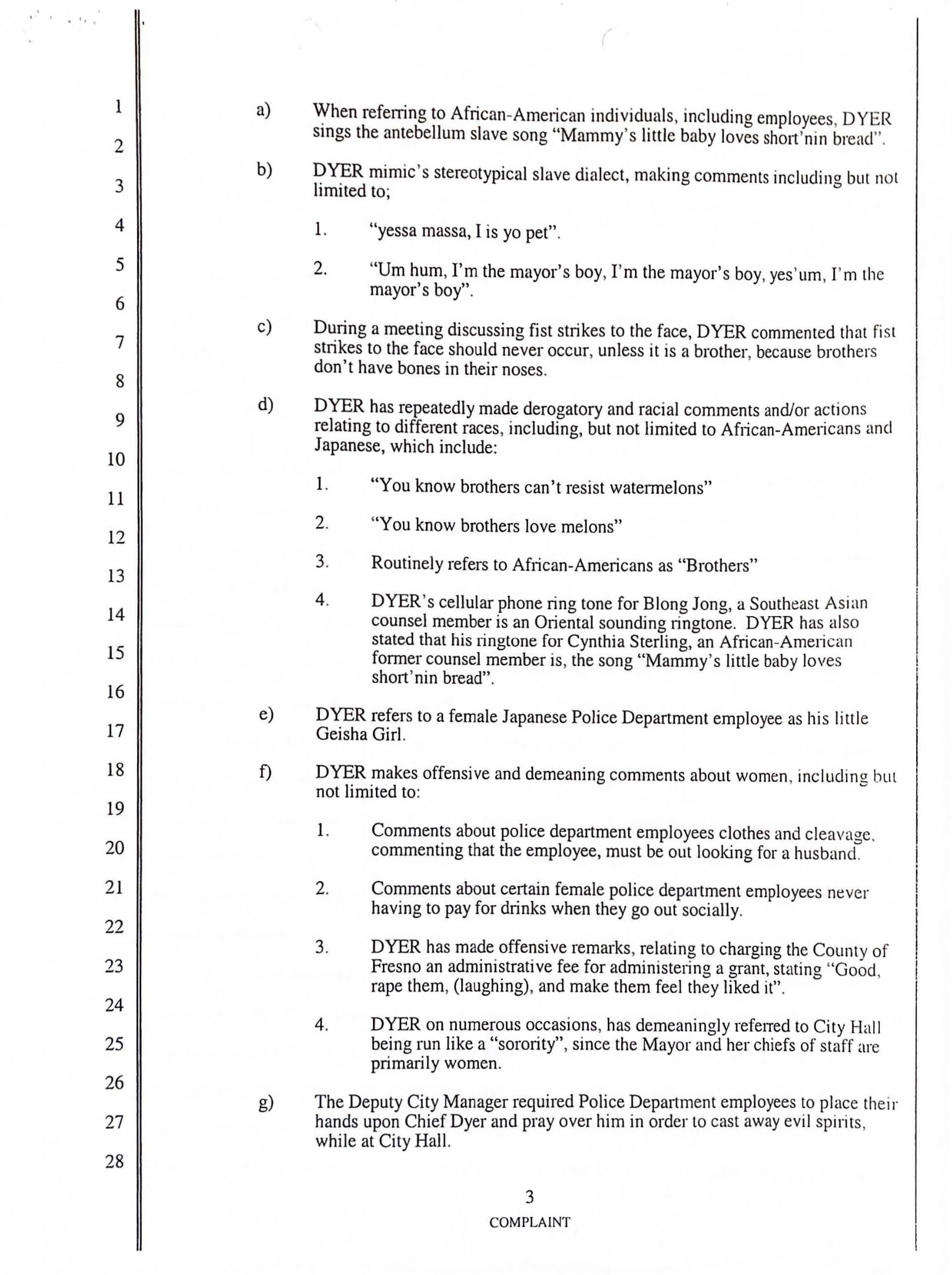
Allegations in their lawsuit included:
- “When referring to African American individuals, including employees, Dyer sings the antebellum slave song ‘Mammy’s little baby loves short’nin bread.’”
- “During a meeting discussing fist strikes to the face, Dyer commented that fist strikes to the face should never occur, unless it is a brother, because brothers don’t have bones in their noses.”
- “Dyer has repeatedly made derogatory and racial comments and/or actions relating to different races, including, but not limited to African Americans and Japanese, which include: ‘You know brothers can’t resist watermelons.’”
- “Dyer’s cellular phone ring tone for Blong Jong, a Southeast Asian council member, is an Oriental sounding ringtone. Dyer has also stated that his ringtone for Cynthia Sterling, an African American former council member, is the song ‘Mammy’s little baby loves short’nin bread.’”
- “Dyer refers to a female Japanese Police Department employee as his little Geisha Girl.”
- “Dyer has made offensive remark relating to charging the County of Fresno an administrative fee for administering a grant, stating ‘Good, rape them (laughing), and make them feel like they liked it.’”
At the time, Dyer said the comments were fabricated, embellished or taken out of context. The Fresno Bee reported that the city paid Nevarez and Shaffer $300,000 to settle the case. Shaffer retired in 2015, but Nevarez worked at the department until this July, when he became the chief of Delano Police Department. In the interview, Dyer said that in the years since Nevarez sued him, the two have become good friends.
He said that many of the comments attributed to him he did not say or were taken out of context.
“I'm not here to rehash any of those things but I'm man enough to say that in those areas that I felt that I was wrong, I took steps to correct that,” Dyer said. “In those areas I think the department was wrong in whatever we've done, I've taken steps to correct that. And for anyone that can say that they've lived a perfect life, they've been a perfect leader, they have a perfect department, they're not being truthful with themselves or others. And I can tell you whatever mistakes have been made by me or this organization, I've learned from it, our organization has learned from it and we move forward.”
When pressed about the rape joke specifically, he reiterated that that was in the past and that it was a “chapter of a book that I've already closed.”
“Right well I can tell you that was completely taken out of context,” Dyer said. “And I'll tell you why, because that was a very acceptable term in law enforcement and it was not intended to offend anyone. But there are certain things that are said in law enforcement that probably would not be acceptable outside of the law enforcement arena. And so I'm not going to necessarily rehash any of that because that's occurred a long time ago that wasn't part of our interview today, quite frankly, and I'm being, quite frankly, gracious in answering some of these questions.”
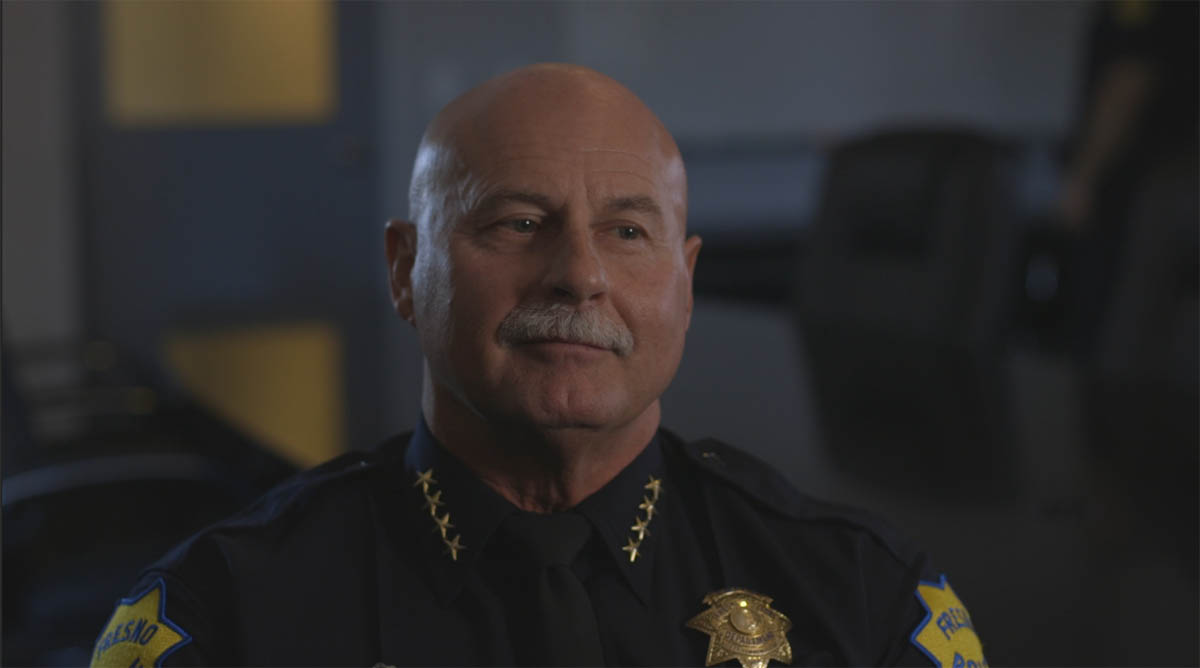
Despite the controversies, the city council, a series of mayors and many Fresnans have steadfastly supported Dyer and the department.
A measure of this support lies in the city’s budget. Fresno spends 50 percent of its general fund on the police department, about $160 million, a share significantly higher than Chicago, Houston or Baltimore.
“Budgets for cities are a value judgment,” said Ron Davis, who directed the community policing office at the Department of Justice.
In cities across the country, local governments are spending more money on their police departments than they ever have. This is a problem, Davis said, speaking at a recent conference commemorating the 50th anniversary of the Kerner Commission, which investigated the causes of the 1967 race riots in American cities. The more cities spend on policing, he said, the less money there is for other social services.
One recent report examined the budgets of 12 cities and found that another California city, Oakland, spent the largest chunk of its general fund on policing, at 41 percent. Had Fresno been a part of the study, its spending on police would have easily outpaced the dozen other cities. Yet, its violent crime rate is about average for California’s 10 largest cities, and well behind Oakland.
“That’s how backwards this city is,” said the Rev. Floyd Harris, a pastor and founder of the Freedom School, an organization that provides vocational training and education to children from Fresno’s southwest. He said the police department gets critical funds that would be better spent on parks or in support of community organizations like his own.
The department hasn’t always drawn such a large share of Fresno’s general fund. The last 50 years’ worth of the city’s budgets shows how the department’s funding has ballooned, accounting for a higher and higher percentage of Fresno’s spending as the city’s priorities shifted.
At the time of the Kerner Commission, just 18 percent of the city’s general fund went to policing, while 10 percent went to parks and recreation. In the decades that followed, spending on parks and policing sharply diverged. In 2018, the city council allocated just 4 percent of the general fund to parks, while spending on police has increased to 50 percent.
With that money Dyer has gained increased power and influence — one religious leader said, “He’s like God in this city.” He maintains a public profile unlike any other local official, appearing in commercials and on billboards across Fresno.
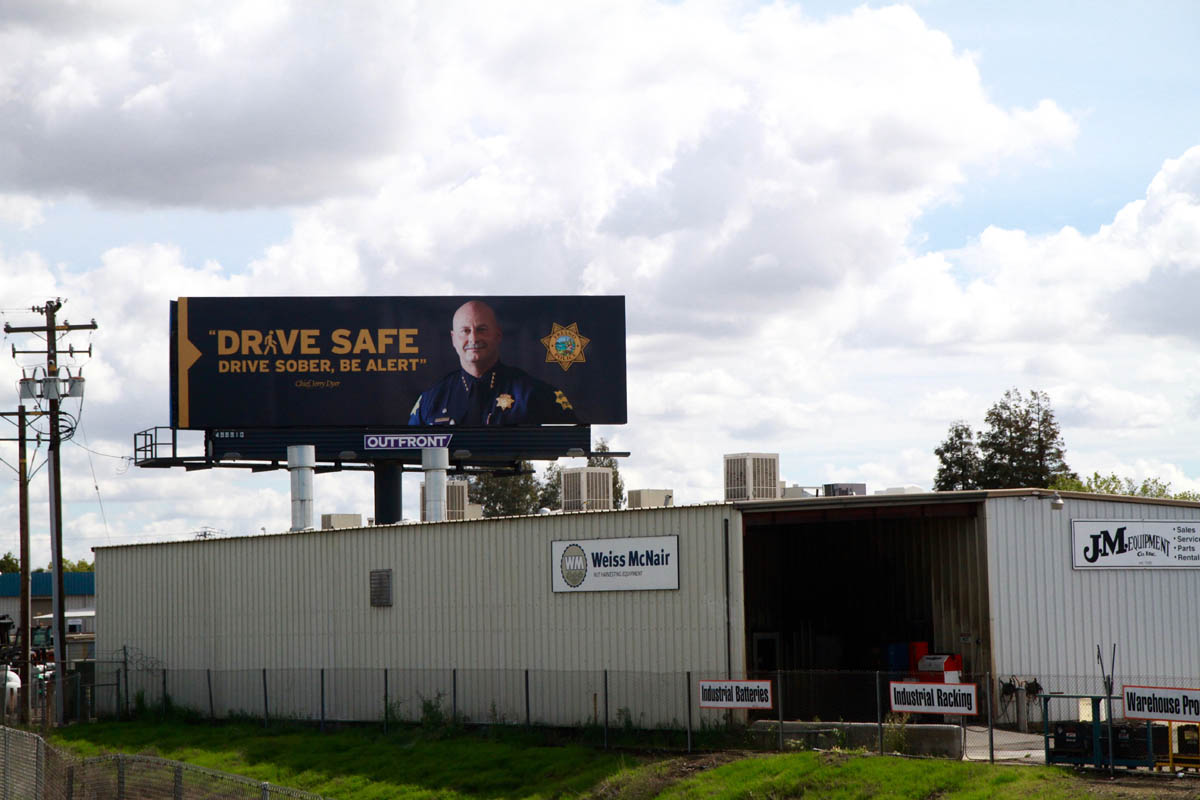
As long as Dyer and the department’s old guard remains in charge, the racial disparities in policing will persist, said Matthew Jendian, who grew up in Fresno and is an advocate for criminal justice reforms.
“Until the leadership changes, I don't know that I have a lot of hope for a lot of bright spots,” he said. “If the leadership is there, then it can shape the culture, and if the culture of the future is influenced by the culture of the past, I'm worried.”
'SCHOOL IS NOT SCHOOL NO MORE'
It’s not just on the city’s streets that black Fresnans are punished disproportionately. It’s in the classroom, too.
Black students in Fresno are punished at a much higher rate than their peers, an analysis of student resource officers’ arrests and citations during the 2015-16 school year shows. Student resource officers are police officers assigned to schools. That year, there were 12 officers in Fresno Unified.
Even though they made up just 10 percent of the schools’ population that year, black students accounted for nearly 30 percent, or 139, of officers’ arrests and citations.
The rate of suspension and expulsions of black and brown students is also higher than the rates for white students, a statewide trend that is particularly profound in Fresno.
Last year at Fresno Unified, one of the state’s largest school districts with over 70,000 students, there were modest declines in suspension rates, but schools still punished black students far more than their white peers. Schools handed down 33 suspensions for every 100 black students, compared to 13 suspensions per 100 white students. This is a disparity twice the state average, which itself is unequal.
Fresno Unified suspended and expelled more black students last year than any other large school district — even Los Angeles Unified, which has more than 8 times the number of black students enrolled in its schools.
Suspensions in Fresno Unified (per 100 students)
“We’ve made gains but we have so far to go,” said Ambra Dorsey, the district’s executive director of prevention and intervention. “We know that the more time kids spend out of the classroom, the less they’re learning.”
Unlike elsewhere in the local justice system, the school district’s leadership is quick to acknowledge the injustice in its uneven discipline numbers, and also the steps they’ve already taken to address it.
School board president Elizabeth Jonasson Rosas said teachers and administrators are rethinking the way they mete out suspensions and expulsions and that, instead of meeting conflict with punishment, they’re using those moments as teaching opportunities. Schools in the district have implemented restorative justice practices and focus on social and emotional learning.
“We’re working on addressing the root causes as opposed to strictly discipline,” Jonasson Rosas said.
Elected to the post in December, Jonasson Rosas replaced a divisive board president whose homophobic comments spurred calls for his resignation.
(The former board president said of inclusive sex education lessons, "if you start telling them that LGBT is OK and that it’s a way of life, well maybe you just swayed the kid to go that way.")
The conservative school district has a history of punitive, disproportionate discipline and it may take years for the numbers to reflect the recent culture change.
“These things do take time but if we don’t start, we’re not going to get there,” Jonasson Rosas said.
“Some children are far more likely to face harsh discipline than others, simply because of their ZIP code or the color of their skin. That's unacceptable and not a reality anybody should be willing to live with.” — Arne Duncan, former U.S. Secretary of Education, in a 2015 statement
Last year, Keion White was a junior at Fresno’s McLane High School when he was suspended for three days after a fight off campus. A couple weeks later, he was pulled out of his first period class and arrested.
“They didn’t give me a chance to talk,” he said. “They just handcuffed me and read me my rights.”
Keion was charged with battery and booked into the juvenile detention center, where he spent the next 46 days in and out of court hearings and serving his sentence. He was released on parole last year, just before Christmas, and returned to school after winter break. His judge told him that, if he stayed out of trouble, he could have his record sealed.
But he couldn’t make one wrong move, and he could feel his school’s police officer watching him.
“Patiently waiting for me to mess up,” he said. “The system is designed to trap you.”
Keion works at a local thrift store, earning money to pay for court-mandated anger management classes. He fell behind in school while he was detained, but he’s back on track to graduate. He wants to study nursing.
However, the rules for his parole are strict — he has a curfew that prevents him from playing for his school’s sports teams — and even the slightest slip up could send him back to court.
The Rev. Floyd Harris said cases like Keion’s are examples of the so-called “school-to-prison pipeline” where discipline at school sets children down a path into the justice system.
“He has to look over his shoulder the rest of his life,” said Harris.
This year, in an attempt to reduce the number of students charged with crimes on campus, the district began a partnership with the Fresno Police Department and the Fresno County District Attorney’s Office. Now, Dorsey said, when students commit misdemeanor crimes at school, the three agencies work together to reduce the number of criminal charges filed.
“We’re actively working to keep kids out of the system whenever we can,” Dorsey said.
Even so, some say the presence of police and their technology in the schools comes at the expense of students’ education.
The department has a network of microphones across the city that triangulates the locations of gunshots, a system known as ShotSpotter. Its use everywhere in the city is controversial, but nowhere more so than in its schools, which partner with the police department and have the technology on 65 campuses.
Last year, the California Department of Education directed the school district to revise a spending plan that used state funding meant for low income students, English language learners and foster children to pay for, among other services, ShotSpotter technology.
The department and the school district say their partnership is necessary to keep students and teachers safe — and is especially helpful in preventing mass school shootings, like the rampage in Parkland, Florida that killed 17 people.
The day of the Parkland shooting, one school board trustee tweeted, “ShotSpotter sounds like a pretty good idea now???”
But advocates say that police in the schools actually harm the very students they’re meant to protect.
“All it does is target people at an earlier age and get them then into a system and makes it difficult for them to get out,” said Jendian, the Fresno State sociologist.
And some say there are better ways Fresno Unified could use its money. According to their contract, Fresno Unified paid the police department more than $1.2 million for at least 12 full-time student resource officers for the 2015-16 school year.
But Jonasson Rosas said student resource officers get special training and often lead activities and workshops in their schools’ neighborhoods. The officers are mentors, she said.
“They’re not just on campus trying to arrest students or find drugs on them or anything like that,” she said. “I think there’s a perception that that’s what they’re doing but that’s not their main role.”
Jonasson Rosas is acutely aware of the well-worn path from schools to prisons and she stressed that her district is moving away from the zero tolerance policies of the past. She said she recognizes that, historically, Fresno Unified’s disproportionate discipline has been part of the problem, a piece of a system that criminalizes black and brown students at a young age.
“I think our entire community, our entire state and our entire nation bears the responsibility,” she said. “Every single one of us does.”
Now, she said, she wants her schools to be a solution.
THREE OPTIONS. NONE OF THEM GOOD.
The disparity in Fresno’s justice system doesn’t stop at the city’s schools and police department.
More than a year’s worth of Fresno County jail booking and release data — obtained from the county sheriff through a public records request and revealed here for the first time — show disparities similar to those found in policing.
Among the findings:
- In Fresno County Jail, black inmates comprise about 15 percent of the jail population — triple the proportion of black county residents.
- White inmates are ticketed and released (as opposed to being held until trial) at a much higher rate than black inmates.
- Since the beginning of 2017, more people have been booked into the county jail from the city ZIP code 93706, with one of the poorest and one of the largest black populations in the county, than from any other ZIP.
- Even when controlling for a defendant's crimes, age and gender, a statistical analysis found that black and Hispanic defendants got higher bail amounts than their white counterparts.
“I don't have an answer as to why the numbers don't match up with the population,” said Steve Wright, a Fresno County assistant district attorney assigned to respond to questions about the disproportionate jailing of the county’s black community.
Wright said that his office tells its staff “that race or sex or gender is not something to be considered” in prosecuting a case.
“We're going to look at the case for the fact of circumstances of what happened, take into account any specific egregious circumstances or any mitigating factors, take into account the defendant's history and try and come to a fair and just resolution,” Wright said. “I don't see any inequities in Fresno.”
Those who decry unfairness likely do so because they don’t understand the system or they have seen one instance of wrongdoing and assume the same thing happens in every case, Wright said.
He said the DA’s office doesn’t have a “racial quota.” It just prosecutes the cases that local police send its way. But policing doesn’t have a race problem, either, said Wright, who also sits an advisory board to the Fresno Police Department.
Jail population by race
Fresno County Sheriff Margaret Mims also said she didn’t know why the jail has a higher percentage of black inmates than the county has black residents. She said she wanted to see more research before speculating about the cause of the disparity, and said that she would support research that tries to answer that question.
“I do know that we’re probably not unlike many counties where the ratio of people who get arrested or who are housed in jail may not reflect exactly the ratio of people in our communities,” Mims said. “I would really like someone to do a very clear study on why that is. That would be a very important study.”
One reason widely believed to contribute to the disproportionate jailing of black Fresnans was money bail — which, until recently, was the law in California.
Money bail has created two justice systems: one for the wealthy and one for the poor. The system for the poor has a pernicious way of keeping people in poverty.
Though the law has changed, Californians will continue to feel money bail's unequal impact.
“It is very hard for people who are justice system-involved to get out and move on with their lives and be productive citizens,” said Lisa Foster, a retired California Superior Court judge. “You basically have more people in Fresno who can’t afford bail. The impact on the community is enormous. You have people who lose their houses, lose their jobs, lose their kids. It exacerbates poverty. It is keeping places like Fresno poor.”
Here’s roughly how it worked: if you were arrested and charged with a crime you appeared in court for your arraignment hearing, where the judge set your bail. If you could afford it, you paid the court in cash. But if you didn’t have the money, you had three options. None of them were good.
You could sign a contract with a bail bond agency. This got you out of jail but likely put you in debt to the bond company.
You could stay in jail and wait for your trial, which could be in 30 days for a misdemeanor or 90 for a felony. If you’re locked up, you could miss work and lose your job, or miss rent and lose your home.
Or, you could just plead guilty. Even if you weren’t. Even if your case was what lawyers call defensible. Pleading guilty, especially to a felony, gets you a record. With a record, everything is more difficult — jobs, housing, education.
These options, and the bail system that mandated them, are illustrative of larger, structural imbalances in California’s justice system.
“It perverts our justice system, it makes a mockery of this whole idea that we're innocent until proven guilty and it causes human suffering to individuals, to their communities, to their families and to all of us as a society,” said John Raphling, a senior researcher at Human Rights Watch. “It's racially-based, it’s economic-class-based, and it’s part of a larger system of oppression that we have in this state — in this country— and if we don't address it then it will continue on and get worse.”
Because money bail affects the poor and people of color more than anyone else, in Fresno, a minority-majority city with the state’s highest rates of poverty, those communities are hit especially hard.
“The entire bail system in California is broken,” said Jendian, the Fresno State sociologist, before the law was changed. “We see the effect of that broken system more clearly and, unfortunately, more heavily in Fresno.”
'CREATING CRIMINALS'
The county jail is one of downtown Fresno’s tallest buildings, a landmark in the city’s skyline.
Inside, the jail is drab and gray.
Correctional officers say they’re overworked and underpaid. Officers keep quitting and it has been years since they’ve gotten a raise.
Inmates say the food is bad and sunlight is scarce. In the main jail, each floor has a library and a weight room. They’re the same place. There aren’t many weights and there aren’t many books. The walls are whitewashed cinder blocks. The “yard,” is actually on the jail’s roof (it’s known as the penthouse) and is covered and surrounded by chain link fences.
Officers and inmates both complain of how dangerous it is inside — the fights, the drugs, the stabbings. Both say they’re afraid.
When you can’t afford to pay bail, this is where you go to wait for your day in court.
Mims, whose agency runs the jail, said that this fear is not how the justice system should work.
“Absolutely not,” she said. One of the things that’s important for correctional officers to know is our job is not punishing the inmates, our job is the safety and security of the inmates.”
She blames the state’s public safety realignment for putting more pressure on county jails like hers. The jail population has changed and violence inside has increased.
On a recent tour of the Fresno jail, an officer showed a group of reporters the booking area, where inmates are stripped, searched and admitted to the jail.
“That’s where they come, freshly squeezed,” he said.
Spend a day in there — especially when you’re innocent or just a low-level offender — and you’re more likely to wind up in jail again.
“Any more than a day in jail increases the likelihood of future criminal involvement,” said Sandra Susan Smith, a professor of sociology at the University of California, Berkeley. “The longer a person is kept in jail, the risk increases. We’re actually creating criminals.”
A large body of research bears this out: one study found that nonviolent, defendants held for two or three days were 40 percent more likely to commit new crimes before their trials than similar defendants who were held for a day or less. Defendants held for one or two weeks are 56 percent more likely to commit new crimes.
“If you’re on the edge, this could push you over,” Smith said. “You’re less likely to trust the system.”
WHOSE FRESNO?
Hear the Rev. Floyd Harris talk about racial inequality in Fresno and beyond.
From his church in the southwest, the Rev. Harris, the preacher and activist, traced the disparities in his city’s justice system back, through Jim Crow laws, to slavery. He sees it as a natural extension of the country’s racist past.
Hand over heart, Harris quoted the Pledge of Allegiance: “‘One nation, under God, indivisible, with liberty and justice’ —” he paused. “Liberty for who? Justice for who?”
It’s a question that politicians, community leaders, law enforcement officials and residents might all answer differently. Depending on their race, depending on their income, depending on their neighborhood.
Depending on which Fresno they live in.
In Dyer’s Fresno, he has steered the department through a recession and intensified scrutiny of police, all while the city’s crime rates fell.
“My job as a police chief is to keep us focused on those things that are important: saving lives, making sure that we're treating people with dignity and respect, building those relationships of trust in a community, reducing crime,” he said. “And that's what we're doing.”
In Harris’ Fresno, the city’s justice system is morally corrupt and the black community has been left to fend for itself.
“This city right now, Fresno, it’s going to be broke down to its knees one day,” Harris said. “It has a lot to pay for for hurting people. If I could tell all my people to move out of here, if I could move them all out of here, I would. That’s how bad this place is. My people are being destroyed. Every day.”
And in Baines’ Fresno, the system is the same as it is everywhere. And that’s just the problem.
“Oh no, the justice system is not set up to treat people equally,” the councilman and former police officer said. “I don't know how I can be any clearer. It's not set up that way. And that's true across the country. Those same rules that we're applying in Fresno apply everywhere and they're not set up to treat people equally. Fresno just follows the rules, like every place else.”


